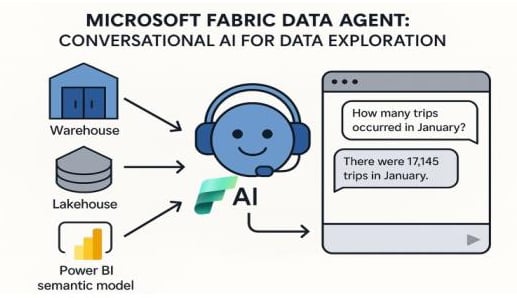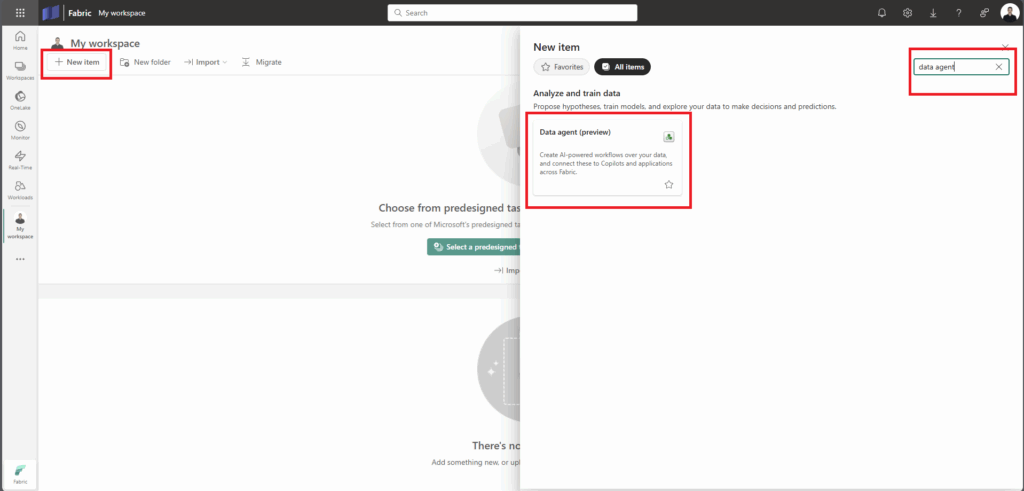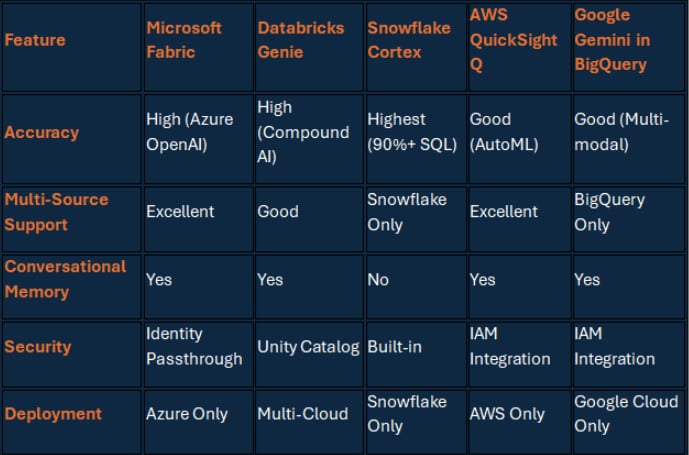Imagine you’re a marketing manager at a bustling retail company. You need to know which products sold best in California during Q4 2024 to plan your next campaign. The problem? You don’t know SQL, and waiting for the IT team to run a query could take days. Frustrating, right? Now, picture typing your question in plain English— “Show me the top 5 products by sales in California for Q4 2024”—and getting an instant answer, complete with a clear explanation and maybe even a chart. This is the promise of Microsoft Fabric Data Agents, a game-changing tool that’s making data analytics accessible to everyone, not just tech wizards.
Microsoft Fabric Data Agents represent a transformative approach to enterprise data access, enabling natural language querying across unified data platforms while maintaining enterprise-grade security and governance. This AI-powered feature democratizes data analytics by allowing business users to interact conversationally with complex data sources, fundamentally changing how organizations extract insights from their data assets.
What Are Data Agents?
Think of Data Agents as your personal data concierge. They’re AI-powered assistants within the Microsoft Fabric platform, designed to democratize data access. Using Azure OpenAI Assistant APIs, they let users ask questions in natural language and receive precise answers from complex data sources like Lakehouses, Warehouses, Power BI semantic models, and KQL databases. Best of all, they maintain enterprise-grade security and governance, ensuring users only see data they’re authorized to access .

Solving the Data Accessibility Challenge
Despite billions spent on data infrastructure, many organizations face a persistent problem: business users depend on technical teams for insights. This bottleneck slows decision-making and limits agility. Data Agents solve this by translating plain English questions into queries across multiple data sources, no SQL, DAX, or KQL expertise required. For example, a sales manager can ask, “What’s our revenue trend this year?” and get an answer without involving IT .
Recent Advancements: A Leap Forward
At the Microsoft Fabric Community Conference 2025, Microsoft unveiled major updates to Data Agents, cementing their role in the company’s unified analytics strategy. Enhanced multi-source connectivity, deeper Azure AI integration, and production-ready features make them a cornerstone for enterprises looking to streamline data interactions.
How Do Data Agents Work?
Think of Data Agents as a super-smart assistant who speaks both business lingo and data. Their architecture, built on Azure OpenAI, orchestrates a five-step process:
- Question Parsing and Validation: Ensures the query is valid and complies with security protocols.
- Data Source Identification: Uses user credentials to pinpoint relevant, accessible data sources.
- Query Generation: Translates natural language into SQL, DAX, or KQL, depending on the data source.
- Query Validation and Execution: Checks the query for accuracy and executes it, respecting security constraints.
- Result Presentation: Delivers answers with clear explanations, often in natural language.
This setup supports up to five data sources per agent, enabling complex cross-platform analytics while maintaining unified security.
Natural Language Querying in Action
Let’s say you ask, “Show me the top 5 products by sales in California for Q4 2024.” The Data Agent:
- Understands you’re looking for sales data, filtered by region and time.
- Identifies the relevant data source, like a Lakehouse sales database.
- Generates an optimized query, such as:
SELECT TOP 5 product_name, SUM(sales) FROM sales_data WHERE region = 'California' AND quarter = 'Q4 2024' GROUP BY product_name ORDER BY SUM(sales) DESC;
- Returns the results, perhaps with a chart or a sentence like, “Here are your top 5 products, led by Product X with $1.2M in sales.”
The system handles everything from simple counts (“How many products do we have by category?”) to complex analytics (“Show services with the highest error rates in the last 30 minutes”).
Power BI Integration: Enhancing Existing Tools
For organizations using Power BI, Data Agents are a natural fit. They let users query existing semantic models conversationally, leveraging established business logic without replacing current workflows. Security settings, like Row-Level Security (RLS), remain intact, ensuring compliance. This means a finance team can ask ad-hoc questions about their Power BI dashboards without needing to build new reports.
Conversational Memory: A Natural Workflow
Data Agents shine with their conversational memory, allowing multi-turn interactions. After asking about California sales, you might say, “Now show me the same for Texas,” or “What were the profit margins for those products?” The system remembers the context, making data exploration feel like a conversation with a colleague. This feature streamlines analytical workflows, saving time and effort.
Real-World Success Stories
Data Agents are already making waves across industries:
- Melbourne Airport: Achieved a 30% boost in data operation efficiency. During high-traffic events like Taylor Swift concerts, real-time analysis optimized operations across aviation, transport, and retail.
- Bridgestone: Cut equipment downtime analysis from 30 minutes to minutes, enabling faster issue resolution and predictive maintenance.
- Iceland Foods: Gained near real-time insights for inventory and staffing, reducing data preparation time and speeding up decisions.
- Accenture/Avanade: Scaled Fabric to 10,000+ employees, with 600+ earning certifications. Natural language dashboard creation transformed daily workflows.
A Forrester study quantifies the impact: a 379% ROI over three years, with payback in under six months, 52% faster data analysis, and 36% more accurate insights.
Configuration: Setting Up for Success
To get the most out of Data Agents, careful setup is key:
- Prerequisites: Minimum F2 Fabric capacity, with F64 recommended for production. Enable Copilot and Azure OpenAI tenant settings.
- Data Source Configuration: Select relevant tables and columns, using descriptive names like “CustomerSales” instead of “Table1” to help the AI understand context.
- Agent Instructions: Define business terms (e.g., “‘Active Customer’ means purchases in the last 12 months”) and usage rules (e.g., “Use GoldLayer_Sales for revenue queries”).
- Example Queries: Provide 3-5 sample queries per data source to train the AI on common patterns.
Testing and refining configurations based on user feedback ensures accuracy.

Developer-Friendly Features
Developers can leverage the Fabric Data Agent Python SDK to create, manage, and evaluate agents programmatically. For example:
from fabric_data_agent_sdk import DataAgentClient
client = DataAgentClient()
response = client.query(agent_id=”your_agent_id”, question=”What are the top 5 products by sales?”)
Integration with Azure AI Foundry enables multi-modal agents that combine data querying with document analysis or image processing. REST API access allows embedding Data Agents into custom apps, while Agent Service integration supports deployment across Microsoft Teams and Copilot Studio.
The Competitive Landscape
Microsoft isn’t alone in conversational analytics. Here’s how Data Agents stack up:

- Databricks Genie: Uses a compound AI approach with strong governance via Unity Catalog, offering flexibility across multiple clouds.
- Snowflake Cortex: Claims top SQL accuracy at over 90%, but is limited to the Snowflake ecosystem.
- AWS QuickSight Q: A mature solution with broad source support and AutoML integration, ideal for AWS-centric organizations.
- Google Cloud’s Gemini in BigQuery: Offers multi-modal capabilities, supporting text, SQL generation, and visualization, but is exclusive to BigQuery.
Organizations should evaluate based on ecosystem compatibility and long-term goals.
Microsoft Ecosystem: Strength and Concern
Data Agents integrate seamlessly with Microsoft 365 tools like Word, Excel, and Teams, embedding insights into daily workflows. Power BI synergy is a standout, extending existing BI investments. However, the Azure-only deployment raises vendor lock-in concerns. Analyst Duncan Van Kouteren notes Microsoft’s push for Fabric as a “control plane” may drive Azure usage but limit multi-cloud flexibility.
Expert Perspectives
Analysts offer cautious optimism. BARC Research ranks Fabric lower for business benefits, suggesting Microsoft has work to do 15. Microsoft’s Fabric CAT team highlights the need for result validation, especially for complex analytics 16. Practitioners praise the capabilities but note limitations like English-only support and structured data focus.
Looking Ahead
Microsoft is rapidly enhancing Data Agents, with 2025 announcements including:
- OneLake Security (Preview): Centralized security models.
- Migration Assistant (Preview): Simplifies transitions from Azure Synapse Analytics.
- Variable Library (Preview): Manages configurations across agents.
- Enhanced Multi-Source Support: Up to five sources with improved context retention.
Experts recommend starting with focused pilot projects, ensuring robust governance, and monitoring Microsoft’s roadmap for maturity beyond preview status.
Technical Specifications and Limitations
- Requirements: F2 minimum capacity, F64 for production. Enable Copilot, XMLA endpoints, and cross-geo settings.
- Data Source Limits: Up to five sources, 25 tables per source recommended, 1,000 tables max for KQL databases.
- Security: Identity passthrough with RLS and CLS compliance. Conversation history persists for 28 days.
- Constraints: English-only queries, structured data focus, no complex reasoning or causal inference.
Conclusion
Microsoft Fabric Data Agents are a significant step toward democratizing data analytics, offering natural language querying and robust Microsoft ecosystem integration. Real-world results, like 30% efficiency gains and 379% ROI, highlight their potential. However, the preview status, English-only limitation, and Azure exclusivity require careful consideration. For Microsoft-centric organizations, Data Agents are a powerful tool to unlock insights. Others should weigh vendor lock-in against competitors’ offerings, starting with pilot projects to test the waters.
As a lead data engineer, I see Data Agents as a transformative tool that augments, not replaces, data professionals. They handle routine queries, freeing us to tackle complex challenges. But success hinges on proper setup, governance, and realistic expectations. The future of conversational analytics is bright, and Data Agents are paving the way for a world where data-driven decisions are accessible to all.

Hadi Amiri
Hadi Amiri is a versatile Deep Learning Engineer and Data Scientist specializing in machine learning, natural language processing (NLP), and cloud-based AI solutions. With a master's degree in electrical and computer engineering, Hadi has excelled in designing and deploying end-to-end AI pipelines, optimizing ETL processes, and building advanced retrieval-augmented generation (RAG) systems. His expertise spans generative AI, uncertainty quantification, and predictive modeling, delivering innovative solutions for industries such as technology, healthcare, and telecommunications. Hadi's ability to lead multidisciplinary teams and translate complex technical challenges into scalable AI architectures makes him a valuable contributor to cutting-edge enterprise transformation
